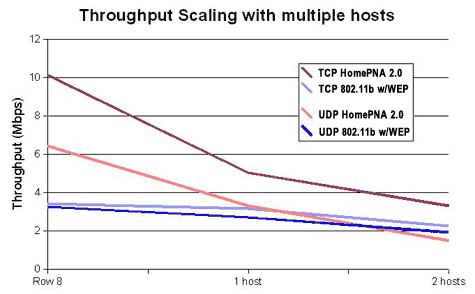Cutting all Cables: Phoneline vs. Wireless Networking
by Eric Hagen on October 30, 2001 4:10 AM EST- Posted in
- IT Computing
Network Scaling
To examine the behavior of a network under a higher load, we duplicated our previous tests, each time adding an additional computer. In order to examine the scaling of the network, we needed to transmit data from multiple sources to other destinations on the same network. During our test, each extra computer actively transmitted to another interface on the same network, effectively increasing the demand on the network by a factor of two.
Note: the number of hosts on the Y-axis are in addition to the two being tested.

It is important to understand that the scaling behavior of these networks is partially due to their topology. The HomePNA 2.0 network is structured as a bus topology, where all computers communicate with each other, negotiating transmissions much like an old 10 Base-2 coaxial Ethernet network. The 802.11b network is structured as a star topology, with an access point processing all data sent or received on the network. The access point acts as an intelligent bridge between a wireless segment and an Ethernet segment. Because of this, the 802.11b network processes data in a much different way than a network on a bus topology.
Clearly, the HomePNA 2.0 network scaled almost exactly with the number of hosts present on the system. When one transmission was taking place, it received roughly 10Mbps. Two each split the data to 5Mbps. When there were three, they each took 3.3Mbps. This linear scaling indicates a very robust scalability and should allow a fair number of hosts without significant degradation in performance.
The 802.11b network is harder to analyze because the bridge (the access point) clearly showed a preference for data coming from the Ethernet segment onto the wireless. Data being transmitted from one wireless computer to another was forced to slow dramatically when multiple transmissions were combined. This may be both positive and negative, but it would depend on the specific bridge that was in use on your network. Further study of this data is clearly warranted.










0 Comments
View All Comments